 | |
|  |
|
|
| |
| Enceladus & star flybys, Black Hole pinball | Apr 18, 2012 1:21 PM PDT | url |
| | |
Added 1 new A* page:Another page, another planetoid! I keep wanting to do one that's, well, not spherical or elliptical, but having done some "research" around Wikipedia today, I think I've finally managed to convince myself that gravity more or less make that impossible--at least if you want to have something large enough to have gravity that holds people to the floor, which I do in this case.
So it had to be roundish. But I still wanted to distinguish its presentation visually in some way from the other similar roundish bleak planetoid thingies I've done in the past. I was looking up some photos of pretty much my favorite moon, Enceladus, and noticed something (this is a cropped repost of part of a set I posted ages ago on the forum):
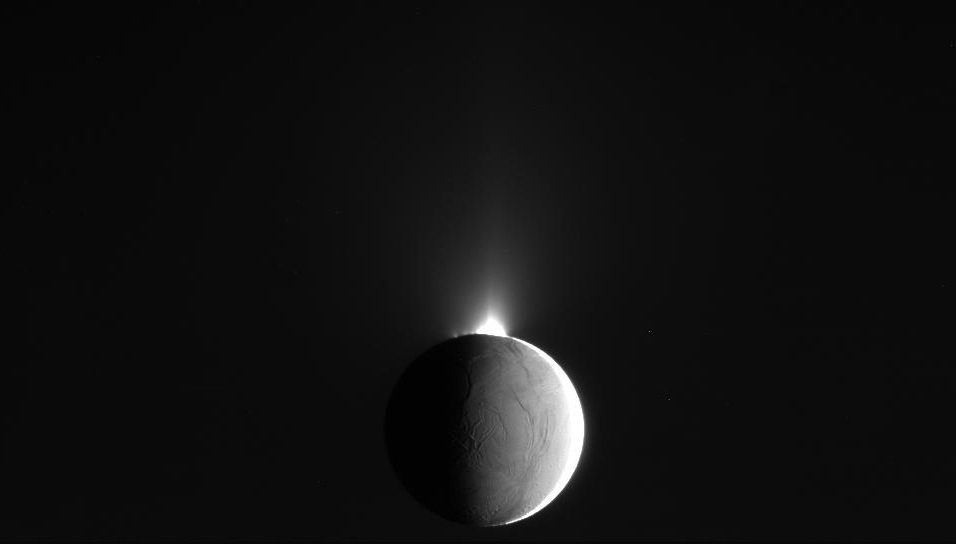
image by NASA (source)
Atmosphere! Actually it's clouds of ice crystals ejected from the moon's cryovolcanoes that now form a faint, thin ring among the many other rings around Saturn. I wanted to do an icy world anyway so I thought I'd go with that nifty space atmosphere look. Wikipedia's page on cryovolcanism says the instances we think we know of cryovolcanoes are thought to get their energy from tidal friction, which is to say the mechanical stress induced on cryovolcanic moons by the gravity of their parent planet slinging them around--and I'm not sure that I want this particular planetoid here being a moon, *but* Wikipedia's page does leave hope for other mechanisms causing cryovolcanism: theoretically they could be powered by radioactive decay, or even a "sub-surface greenhouse effect" enabled by "translucent deposits of frozen materials."
Anyway, back to Enceladus. Here's a nice mosaic image looking south from its north polar region that gave me the idea for the lighting on today's A* planetoid (although I somehow got it exactly backwards in the initial stages but nevermind :p):
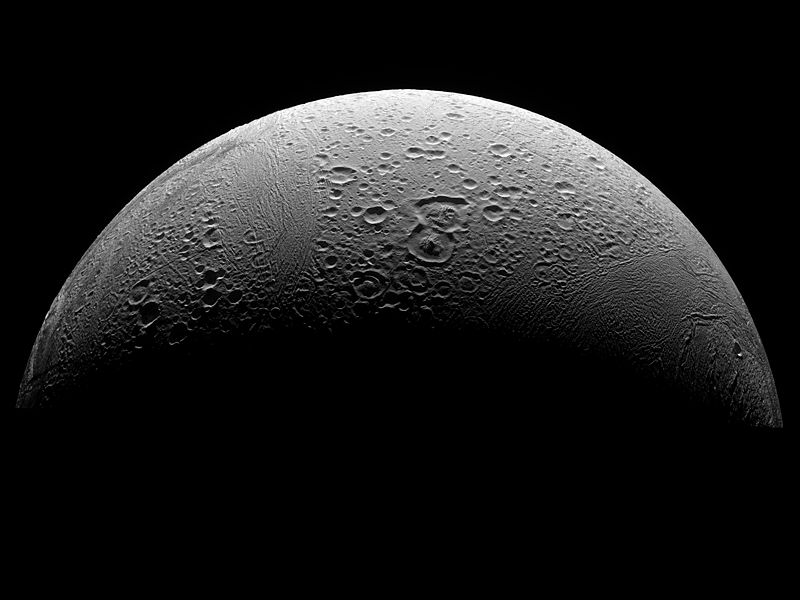
image NASA/JPL/Space Science Institute (source)
The three photos used in that image, like pretty much all the decent photos of Enceladus, came from the Cassini probe--a 2008 fly-by, in this case. But Cassini's still going, and in fact just did another flyby of Enceladus, passing within 46 miles of the surface a few days ago, on April 14th--it flew through some of the geysers of ice crystals shooting out of the moon's "tiger stripe" surface fractures. A fresh photo from that flyby helped give me the idea for showing a planetoid in nearly pitch-black aspect:
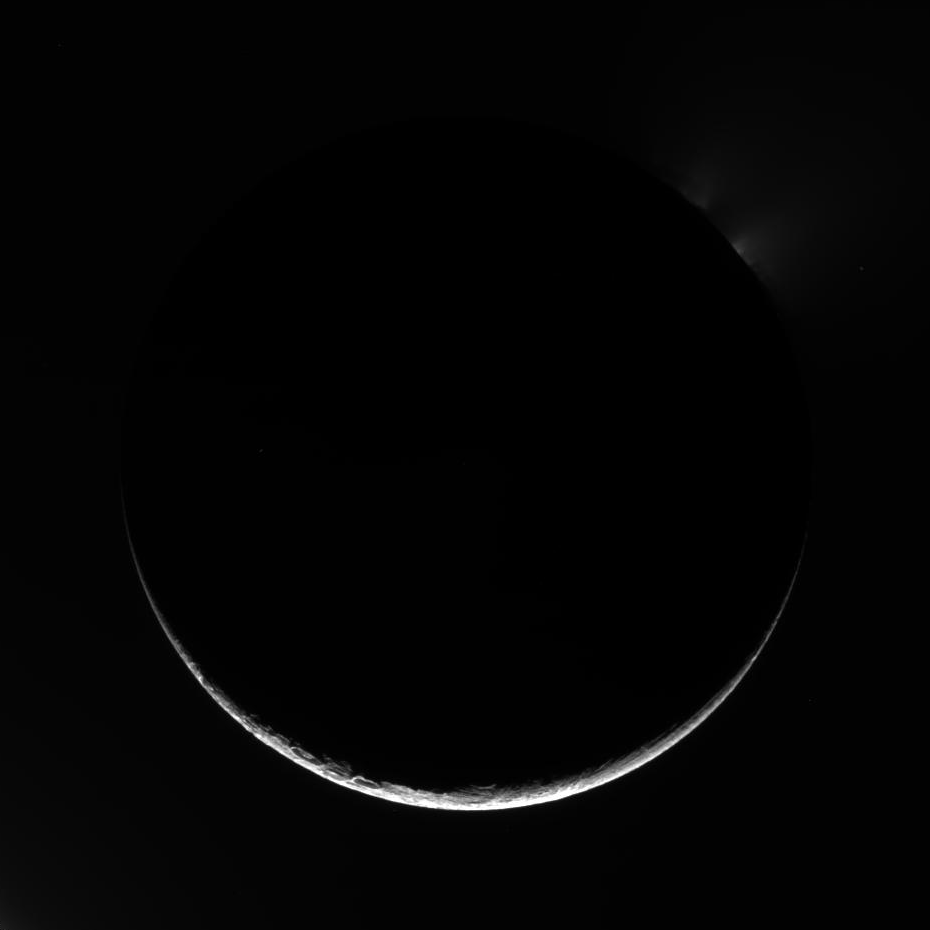
image by NASA/JPL/Space Science Institute (source)
~~~~~~~~~
I posted a few early stages of today's page to A*'s Twitter, Facebook, and G+ accounts as I was making them earlier today. Here they are and some later ones I haven't posted before now because they were causing me some consternation:
I probably should have stopped with this nice energetic initial outlay of black:
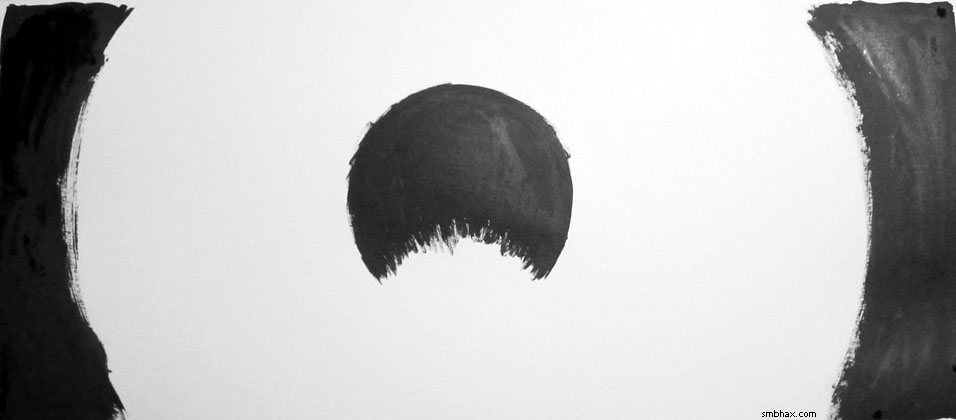
Or after the first ink wash to establish the "space atmosphere" effect:
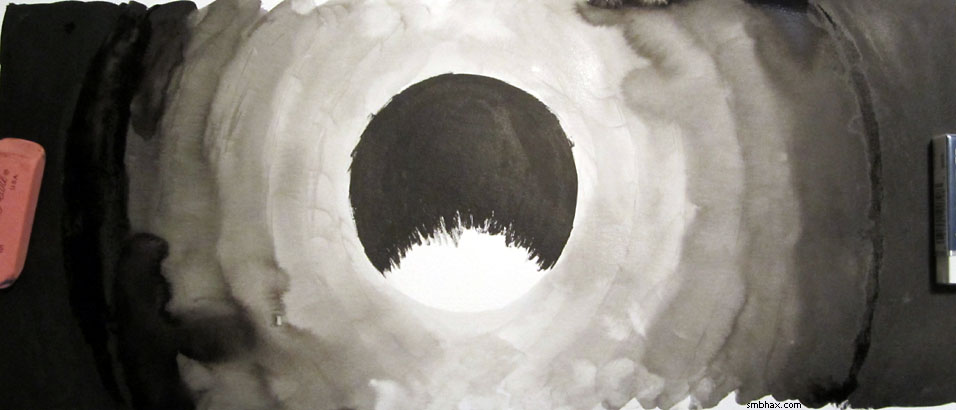
But I decided that was too bright still--I made this mockup in Photoshop from that ^ scan to convince myself going darker would be closer to what I wanted:
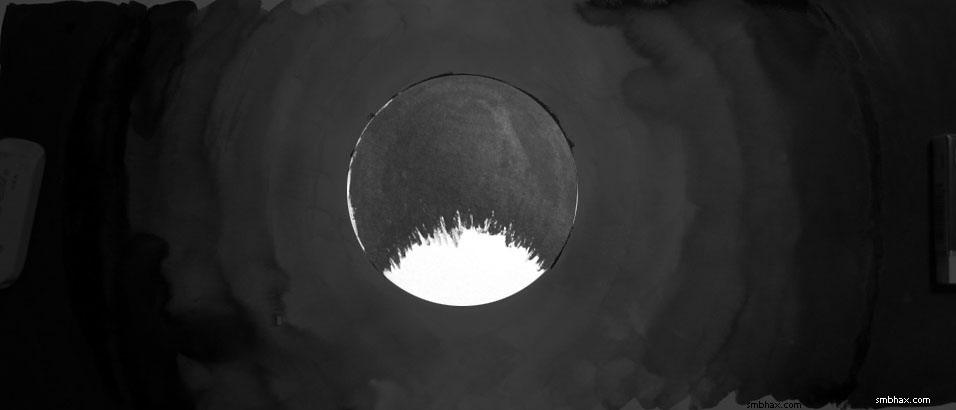
So after a bunch of washes and star spattering (had to use my old non-waterproof white ink for that--the gluey waterproof stuff tends to spatter in strands) and re-painting over the planet with straight waterproof ink which I figured would a) make it extra black and b) give it a bit of maybe ice-like texture from the shine using non-watered-down waterproof ink gives--the gleam of all that lacquer, you know, I had...a blurry, warped, wavy looking planet :P:
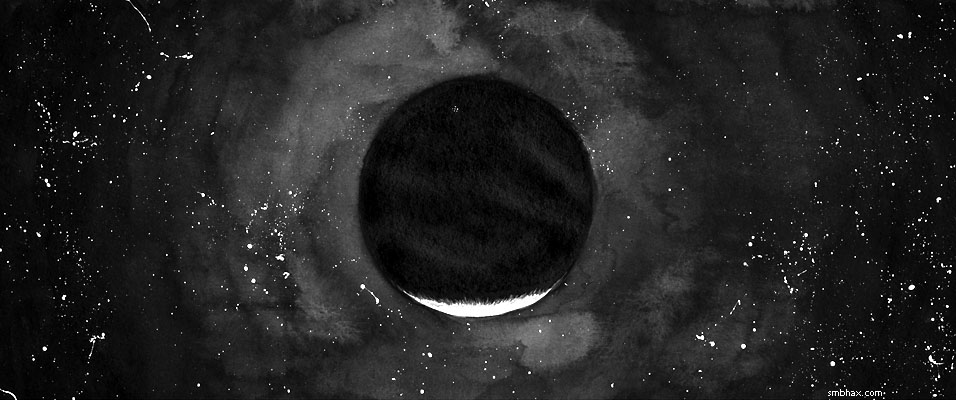
That was no good, so I tried dulling the gleam and straightening out the planetoid's profile with black marker, as well as sharpening up the horizon with a thin wash of the non-waterproof white ink:
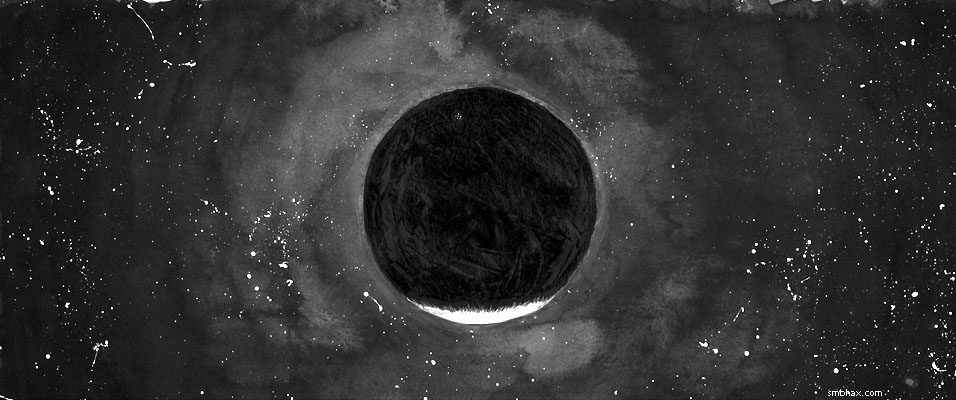
...which rather backfired, as I now had a super-dark planetoid full of marker-line gleams, and even less round than it had been. So I went back over it with watered-down black ink to kill the gleam, and, after using a Photoshop mockup with a computer-drawn circular overlay to show me where the not-so-round parts were sticking out (as I'd noticed was a side benefit from my earlier computer mockup), touched up the edges some more with marker and white ink wash, and finally white waterproof ink when I wasn't satisfied with the sliver of sunlit area I'd whittled it down to. And then wet down the back and squished it under heavy stuff on the scanner glass for a while until it decided to scan with a reasonably even black on the planetoid--which finally worked after some persuading, thank goodness. (Note to self: this is why you need to do that ink round-up and see if you can't find yourself a nice, really dark matte black ink. :P)
And that's just how simple it was to get the final version! :P
Good gravy I am bad at drawing round things that don't fit the sweep of my elbow or wrist. ;P I should smarten up and just use a protractor or jar lid or something, I suppose--but then what would I do with myself for the rest of the evening? :PP
This was also an interesting one in that I usually use Photoshop's "Auto Levels" function at default setting in my macro to recalibrate the scanned image to cover the full gamut from true computer black (ie RGB 0, 0, 0) to full white (RGB 255, 255, 255), so it doesn't look washed out just as a result of the scanner's lighting and capture ability, but doing that on this one made it come out way too contrasty--turns out Auto Levels' 0.5% black and white clip values (in my ancient 4.0 version of Photoshop, in the Auto Levels window, I have to hold "Alt" to change the "Auto" button to an "Options" button to see/change the clip settings--I didn't discover that until a month or so ago and have kind of been wondering about it ever since) were totally clipping past the stars and light part of the planet here, so the light end as a result was being boosted way too much, since it tried to make a full white out of probably some of the grayish atmospheric stuff around the planetoid. Checking in the significantly less ancient Photoshop CS2, the default clip values there appear to be 0.1%, which doesn't stomp the far ends of the value gradients nearly as much, so I guess I'd better use that in Photoshop 4.0 instead of 0.5% like I had been (which I *think* was the default, although I suppose I can't be sure since there's no way to reset it to the default, at least not within the program :P); the difference is scarcely visible in most of my pages, but for ones like this one (okay so this is the only one I've noticed it really needing tweaking on so far) where there are very few pixels at one end of the spectrum, it certainly makes a big difference. So! That...is good to know, and now my beloved ancient version of Photoshop is riiiiiight up to speed >_> and I can do more subtle shading.
~~~~~~
A neat Christian Science Monitor article at abcnews.com on supermassive black holes was shared with me on Facebook. Thanks, Dave! The article describes a theory of what supermassive black holes feed on, and where "hypervelocity" stars zooming out of our galaxy get their high speed--about 20 have been spotted since 2005--and these were predicted by Los Alamos astrophysicist Jack Hills back in 1988, who said that the tell-tale sign of a central supermassive black hole in our galaxy would be lone stars catapulting outward faster than 1 million miles per hour (light speed is about 671 million miles per hour, by the way).
The idea is that when binary stars fall too close to the supermassive black hole--and because they orbit each other at quite a distance, they only have to fall within about one Astronomical Unit (the distance from the Earth to the Sun, about 93 million miles) of A*, whereas a lone star would have to get as close as the distance between the Sun and Mercury, which is close to just a third of one AU--one of the pair gets stripped off by the hole's huge gravity, and flung outward at high speed. The other is pulled into a cloud of similar stellar "orphans" orbiting the hole; eventually, that cloud is disrupted when one star too many drifts in, and their own resulting gravitational interactions eventually result in one of their number plunging down into the supermassive black hole, which releases a mighty energy flare as the doomed orphan star is consumed. Such flares, "a so-called tidal disruption event," have been seen in the cores of other galaxies, and based on that, it is calculated that A* might eat a star and send out a flare "once every 1,000 to 100,000 years" (which seems like a rather wide range, but hey).
The new research behind this article had to do, I think, with calculations of just how much mass the black hole could expect to gain from this binary-eating mechanism: "it could explain how black holes in some of the largest elliptical galaxies, with central black holes of several billion solar masses, can bulk up when the galaxies they inhabit have so little gas to feed on." The researchers hope to refine their estimates as more sensitive telescopes let them spot more escaping stars.
(Nearly a couple years ago now, I made a news post about a similar theory--this one seeking to account for the existence of blue hypergiants flinging out of the galaxy, since their trip from the galactic center must have taken something like 100 million years, and blue hypergiants only live about 20 million years: the idea was that they actually come from trinary stars that drift too close to A*: A* pulls off one, violently flinging off the remaining binary, and then the two stars in that binary merge to form the hypergiant on their way out of the galaxy.)
~~~~~
Stretching the black hole topic even further, I've been playing a re-creation of a mid-80's Gottlieb pinball table, "Black Hole," in a new pinball game collection called "The Pinball Arcade"; it's available on all sorts of portable and otherwise systems--I've got the PS3 version. "Black Hole" was the first pinball table to cost a super-massive 50 cents--and as a result, it was the most profitable of all time, or something like that. These black holes, they're relentless I tell ya!
When you start a game on the Black Hole table, a computery voice ominously declares "NO ONE ESCAPES THE BLACK HOLE." The big gimmick is that you can get swallowed down into a small, reversed pinball table revealed beneath the glass floor of the main table; and that table is really tricky, so basically you want to get out as soon as you open the "gate" that will allow your safe "re-entry" to the main table. It's really scientific! Anyway here's a demonstration play by the game's creators, although it skips the start-up voice, alas:
video on Youtube
I'd like to think that if Gottlieb was still around, they'd release a "Supermassive Black Hole" follow-up, that would cost...eh...4 million times the mass of a regular table rather than just two times...where's my calculator...$1,000,000 per play! Ka-ching!
|
·····
|
|
|
